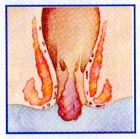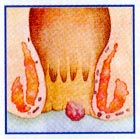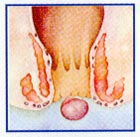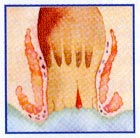What are the symptoms of hemorrhoids?
Many problems of the rectoprostatic area, including Anal Fissure, anal fistula, Perianal abscesses, or irritation and itchy anus/bottom (Pruritus Ani), have similar symptoms and are mistakenly identified as hemorrhoids. Usually, Hemorrhoids are neither dangerous nor life-threatening. Rarely, a patient may experience heavy bleeding or severe anemia. However, they have a major impact on the daily life of patients and degrade their quality of life.
Although, many people have hemorrhoids – swollen hemorrhoidal plexuses – not all of them show symptoms. For example, an internal hemorrhoid can protrude from the anus and become painful and irritating. These are known as prolapsed hemorrhoids (see album). The most common symptom of internal hemorrhoids is bleeding, with a light red tint that overlaps the stools and is seen on the toilet paper or in the pelvis, which is solely due to the mucosal cracks that covers the hemorrhoidal plexus.
Symptoms of external hemorrhoids may include painful swelling or the formation of a hard mass around the anus, caused by the formation of a clot within the hemorrhoidal plexus. This is a serious complication known as external hemorrhoid thrombosis or a hemorrhoidal thrombosis crisis. (see album)
Hemorrhoids usually thrombose after an acute episode of constipation or repeated diarrheal stools, after sudden weight lifting and during pregnancy. Hemorrhoid thrombosis causes an acute and excruciating pain to the patient, so severe, that the later can neither sit down nor defecate. The thrombosis progresses to necrosis and ulceration of the hemorrhoidal nodule. The microbial infection and perforation of these thromboses is a particularly serious complication with high fever and requires immediate surgical treatment.
In other cases, hemorrhoidal symptoms disappear on their own within a few days. But, in most cases, the hemorrhoids recur, often in an aggravated form. In addition, strenuous exertion, running or rubbing around the anus can irritate the hemorrhoids with bleeding and/or itching and cause a vicious cycle of symptoms. Itching can also be caused by dried mucus.
It is necessary to stress that in any case in which there is a loss of blood in the stool, the patient should consult his/her doctor to exclude the possibility that the bleeding is due to another more serious disease of the large intestine.
Internal hemorrhoids occur at the upper part of the rectum where they are not visible. Hemorrhage (bleeding) is the most common symptom of internal hemorrhoids, and often the only one in mild cases.
Sometimes, the internal hemorrhoids exit the anus in the intense effort exerted to mobilize the intestine. This is called internal hemorrhoid prolapse. In some cases it is difficult to facilitate their recovery to the anus and usually it is quite painful.
External hemorrhoids are under the skin around your anus, where there are many more pain-sensing nerves. They usually present without symptoms. When they become irritated, however, they become red and sensitive.
Symptomatic external hemorrhoids often present as a bluish-colored painful lump just outside the anus. They tend to occur spontaneously and may have been preceded by an unusual amount of straining. The skin overlying the outside of the anus is usually firmly attached to the underlying tissues.
When a blood clot forms inside an external hemorrhoid, it often causes severe pain. This thrombosed hemorrhoidal nodule is palpated as a tight and tender mass, the size of a bean or much larger, in the anal area.
Anal fissure. Anal fissure is a small tear in the thin, moist tissue (mucosa) that lines the anus, that may cause itching, pain and bleeding when the bowel is moved.
How are hemorrhoids diagnosed?
If bleeding from the anus or in the stool is noticed, it is important to resort to your specialist doctor for a careful clinical examination. Bleeding may be a symptom of hemorrhoids or other bowel conditions, including anal cancer. The doctor examines the anus and rectum to check for the presence of swollen blood vessels, which are indicative of hemorrhoids, and also performs a finger examination of the rectum to palpate anything abnormal.
Closer examination of the rectum to detect hemorrhoids involves the use of an Anoscope, a shallow lighted tube useful for viewing internal hemorrhoids, or a Proctoscope, useful for a more complete examination of the entire rectum. To exclude other causes of intestinal bleeding, the doctor should examine the rectum and the lower colon by sigmoidoscopy or the whole colon by Colonoscopy. Sigmoidoscopy and colonoscopy are diagnostic methods which also involve the use of a lighted, flexible tube inserted into the rectum.





